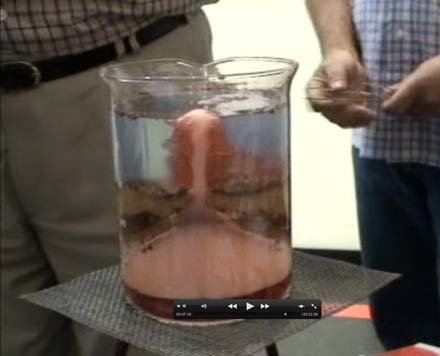
Hotspot Eruption in the Classroom
One advantage teaching science has over pretty much all other subjects is the ability to bring in cool demonstrations and hands-on activities to introduce and reinforce concepts. Here is a fun demonstration, created by Portugese teacher and 2009 School of Rock participant Helder Peirera, to show how a hotspot in the ocean can create a volcano (like the ones in the Louisville Seamount Trail). Materials and instructions are below, but if you want to see a video of what it looks like first, click on the video link with the “Hotspots and mantle plumes” activity on this webpage http://www.es-loule.edu.pt/biogeo/clube02_en.html.
Hotspot Demo
Supplies:
- Glycerin soap (available at a craft store like Michael’s)
- Liter beaker
- Beaker stand
- Wire mesh (to allow beaker to rest on stand)
- Sand
- Water
- Red food coloring
- Alcohol lamp (or Bunsen burner, anything that produces a point of heat)
- Denatured alcohol
- Safety goggles
Procedures:
- Prep work: Set up the beaker for the demo a day in advance to give time for the fine particles in the sand to settle. Cut up about 200ml of glycerin soap in the beaker. Place one drop of red food coloring on the soap. Place in the microwave for 10-20 seconds until it melts and covers the bottom. Let the glycerin soap cool and solidify, which will probably take a couple hours. Once solid, put about 500 ml of sand in the beaker so it forms a layer over the glycerin. Gently pour about 200 ml of water in the beaker over the sand and let it sit over night to allow particles to settle.
- Tell the students they will be seeing a demo of how an underwater volcano can form. Show them the beaker. Tell them (or have them figure out) that the red layer represents the asthenosphere, the sand layer represents the lithosphere and the water represents the ocean.
- Set up the beaker on the stand so it is in view of all the students but out of reach. The beaker should be 3-4 inches above the wick.
- Have everyone put on safety goggles and then light the wick of the alcohol lamp (nothing dangerous will happen, but we still want to encourage safety). Tell them that the flame is like heat from the Earth’s core that rises to create a hot spot. This demo will take somewhere between 5 and 15 minutes before an eruption so encourage them to keep an eye on it, but you may need to have another activity going while they are waiting.
- When the glycerin finally erupts, talk about how heat makes asthenosphere magma rise and expand. If the magma builds up enough pressure, it can break through the lithosphere as lava.